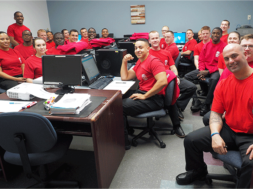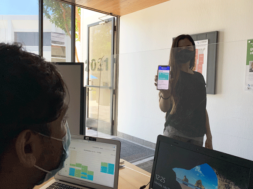
Improving Interdepartmental Cooperation: He Doesn’t Know the Rules! But Neither Does She!
By Stephen T. Chema II, and Ben Walker, Ritzert & Leyton, PC
Disclaimer: The contents of this article do not constitute legal or regulatory advice or counsel. Neither do they establish an attorney-client relationship of any sort. No person or entity should act, or refrain from acting, on the basis of the information discussed herein without seeking individualized, professional counsel as appropriate.
In order to participate in federal financial aid programs (i.e. Title IV), every school must continually demonstrate its administrative capability. Active cooperation among the various departments is a critical component in demonstrating such capability. Similarly, an inability (or unwillingness) among departments to cooperate effectively, achieve common goals, and maintain consistency in policies and procedures impacting students can undermine the ability to show administrative capability. This can pose significant problems because failure to demonstrate administrative capability to the satisfaction of the U.S. Department of Education (“Department”) can lead to loss of eligibility to participate in Title IV programs. See 34 C.F.R. § 668.16 (“Standards of administrative capability”).
Yet in addition to regulatory requirements, efficiently operating an institution that provides a quality academic experience to students requires staff members cooperate effectively.
Remember that every employee has a common goal: providing a setting so that students receive the highest quality educational experience.
Working towards this goal helps ensure that students are in a position to engage with their program (including their instructors and classmates), excel academically, graduate with a valuable credential, and ideally obtain a job in their field of study. When various departments work together with this common vision in mind, the positive impact upon overall student satisfaction can be enormous. Yet the converse is also true, as when staff are not working together cooperatively to provide clear and consistent information to students, students come away with a more pessimistic and negative view of the institution itself.
For regulatory and overall compliance purposes, the central focus of the Department and other regulators is financial aid. The way in which every Title IV participant manages, disburses, and accounts for federal funds is the paramount focus for the Department in terms of its oversight and enforcement. So when thinking about the importance of interdepartmental cooperation, the ways in which policies and procedures observed in other departments impacts financial aid should guide internal operational considerations.
Very often, external forces drive a considerable amount of the changes necessary at a college. Examples include regulatory changes instituted by the Department, but also changes to requirements at the state or accrediting agency levels. Evolving to ensure ongoing adherence to and compliance with these types of externally-imposed changes that impact institutional operations requires organization, focus, and the ability to take decisive action. Yet decisive action alone will not serve the organization well if the decision-makers did not get feedback from staff members and objectively assess how a change in policy or procedure in one department can have a significant ripple effect upon operations in other departments.
Consider an example in which instructors, for purely academic reasons, want to implement a required attendance policy and change the procedures associated with attendance tracking. This can significantly impact the regulatory status of the institution (i.e., whether it is considered attendance taking or non-attendance taking for return to Title IV “R2T4” purposes) and its refund obligations. It can also directly impact day-to-day operations in the registrar’s office, bursar’s office, and certainly the financial aid department.
Types of departmental activities which impact financial aid
The following list offers some ideas about how other departments often impact, directly or indirectly, the policies and procedures associated with the disbursement of federal financial aid:
- Academics:
- Attendance – taking attendance impacts R2T4 calculations as well as Satisfactory Academic Progress (“SAP”) determinations;
- Grading – again, SAP and R2T4;
- Basic eligibility assessments – determining whether the student meets prerequisite requirements (especially if it relates to prior schooling);
- Credit transfers – assessing whether or not credits earned may be transferred into the current program.
- Admissions:
- Institutional eligibility requirements – determining whether the student meets the school’s requirements to be admitted;
- Title IV eligibility requirements – obtaining information to allow for an assessment of whether the student is eligible for Title IV aid;
- Potential misrepresentations – providing inaccurate or incomplete advice to student regarding:
- Transfer of credits;
- Program costs;
- Nature, age, and availability of equipment;
- Employability of graduates; and
- Other requirements (see 34 C.F.R. Subpart F (§§ 668.71-74).
- Bursar:
- Credit balances – providing students any credit balances in a timely and accurate manner;
- Ways to make (or receive) payments – offering ways for students to pay for their educational costs and/or receive refunds (e.g., cash, check, debit card, electronic funds transfers (“EFT”), etc.);
- Tracking of student payments – accounting for payments received from students to cover fees or other equipment.
- Career services/placement:
- Misrepresentations – ensuring students receive complete and accurate information regarding the services provided as well as the results obtained by graduates in terms of employability, licensing exam pass rates, etc.;
- Gainful employment reporting – tracking and publishing accurate information regarding placement rates of graduates consistent with the Department’s instructions;
- Accreditation reporting requirements – collecting information and accurately reporting data pursuant to the instructions provided by the relevant accrediting agency(s).
- Registrar:
- Misrepresentations – ensuring students receive complete and accurate information about the institution’s policies and procedures, in particular those related to:
- Transfer credits;
- Reasons the institution may (or must) terminate a student’s enrollment;
- Course prerequisites.
- Withdrawal policy – providing clear and accurate information about how a student may withdraw from the institution, including both official and unofficial withdrawals;
- SAP – offering clear guidance regarding the institution’s SAP policy (including how it assesses the qualitative and quantitative components, the impact of SAP upon eligibility for Title IV aid, and how one can appeal a SAP determination).
- Misrepresentations – ensuring students receive complete and accurate information about the institution’s policies and procedures, in particular those related to:
- Security:
- Clery Act requirements – ensuring complete and accurate reporting for Clery Act purposes (see 34 C.F.R. § 668.46);
- Campus crime reporting – tracking and reporting data for the institution’s annual security report.
- Senior administration:
- Individuals responsible for setting institutional policy.
Senior administration also impacts financial aid operations
Members of an institution’s senior leadership also have an impact upon financial operations. They do so directly – by setting or approving policies and procedures which the financial aid department then follows on a routine basis. But they also do so indirectly when they assist other departments in the implementation of policies and procedures (such as those described above). Senior leadership who should regularly assess how well the various department operate, communicate, and cooperate include those with titles such as:
- Dean, chancellor, or president;
- CEO;
- CFO;
- Vice presidents;
- General counsel;
- Compliance director;
- Campus director;
- Department heads; and
- Coordinators (such as those who help ensure proper implementation of Title VI/VII (of the Civil Rights Act), Title IX, and the Americans With Disabilities Act (“ADA”).
These types of senior leaders set the tone for the entire institution.
When they encourage (or even demand) cooperation between staff members, the various departments will tend to operate more smoothly, engage with one another more collegially, and arrive at solutions which best benefit the student experience.
In turn, this inspires staff members to have the confidence to raise issues – such as the impact a proposed policy may have on another department or a compliance concern regarding a new procedure – which they may not have concerned themselves with previously. Taking advantage of the combined institutional and experiential knowledge of the entire staff can reap substantial rewards. It will help improve the academic experience for students, improve operational efficiencies, and allow for more open communication.
This is not to say that individual staff members should be looking over the shoulders of their co-workers, conducting personal “compliance reviews,” or engage in second-guessing once a decision has been made or a policy implemented. Instead, the focus should be on providing avenues for communication which can generate discussion and lead to a team-oriented way to update policies, adapt procedures, and maintain compliance in an ongoing fashion.
Compliance considerations
Site visits
Coordination and cooperation between departments and co-workers is also critical because of the message it sends to regulators.
An institution whose employees present a unified and consistent message about its policies and procedures will impress site visitors.
It will do so by showing (rather than simply telling) that staff members are familiar with internal operations, can provide effective information to outsiders (and thereby students), and communicate with one another effectively.
For example, if the Department conducts an on-site program review, the visiting team may want to talk with members of multiple departments about the official withdrawal policy. If a staff member in the admissions department states that withdrawals are official only if provided in writing to the registrar. Next, the registrar informs the team that a student can officially withdraw in writing or verbally by talking to the registrar or any instructor. Finally, an instructor informs a team member that she is not sure about the withdrawal policy, but would instruct a student to talk to the student services department. If any visiting team received this type of inconsistent (and possibly conflicting) information about a fairly fundamental policy, it is likely to pique their interest, cause them to dig deeper into institutional policy and procedure, and potentially increase the scope of the program review.
Contrast that scenario with one in which staff members in those various departments are familiar with the withdrawal policy and consistently explain that in the event a student wants to withdraw, he or she would be told to visit the registrar’s office. Those same staff members state that they would immediately contact the registrar if a student expressed his/her intent to withdraw so that the registrar could contact the student and handle the situation consistent with institutional policy. Alternately, it would be sound for any staff member unfamiliar with details of the procedure in question to state, “I’m not certain exactly how that would happen, but I would ask someone in the registrar’s office if I had a question. I am sure they would explain the official withdrawal policy to you, just like they would to me.” The expectation is not that every staff member have intimate knowledge of every procedure in every department. Instead, it is to ensure staff members know to whom they can go with a question or identify the department most likely to have the detailed knowledge.
Human resources considerations
Human Resources (“HR”) consideration should be another important reason to create a cooperative and well-coordinated environment. HR can identify specific organizational responsibilities. This will allow the school to minimize overlap as well as implement necessary checks and balances.
For instance, having someone in the bursar’s office periodically double-check attendance entries in the database against instructor’s class rosters can provide substantial reassurance regarding the accuracy of data critical to financial aid disbursements.
In addition, the negative impacts which flow from non-cooperation are substantial. Infighting and finger-pointing can create a corrosive atmosphere, leading to poor morale. This, in turn, can lead to substantial employee turnover and the associated problems of hiring churn, lack of institutional knowledge, and inadequate continuity from year to year.
Considering the converse, the positive aspects of a cooperative work environment for HR purposes is also instructive. Employees who work collaboratively to develop policies and procedures are typically more willing to implement them effectively because their input was considered. Policy statements become more useful because they are written clearly and concisely based upon the actual language which would be used at the school. Areas of responsibility become clear, yet staff members become more comfortable discussing issues or concerns with others who might offer a good solution or approach. As such, staff members are ready to engage proactively in the event of an unannounced site visit (by the Department, for example). They can also more readily respond to an emergency situation and thereby lessen the likelihood they will “freeze” in a pressure situation requiring quick action.
Practical considerations
When an institution works towards creating more opportunities for interdepartmental communication and cooperation, some practical considerations spring to mind. These include working to ensure information flows effectively to the proper employees. Think about which department needs to provide input about a particular policy, then circulate proposed policy language for review and comment. This also provides an opportunity to ask whether anyone else can assist or should be involved.
Then, once a policy statement is finalized, solicit feedback from others, including those who might not have been involvement in that specific area. Can someone unfamiliar with the topic nonetheless understand the policy? Can they identify unclear language or assist in eliminating jargon or extraneous detail? Alternately, is there detail which is missing or a concept requiring clarification? A fresh set of eyes can greatly improve an institutional policy statement.
Training ideas
Developing a culture of cooperation does not happen overnight or based upon a top-down instruction. A management directive to “cooperate, or else” is both overbearing and ultimately ineffectual. Instead, think about ways to train staff members that will help them develop empathy and understanding for the role other departments play in the overall educational process.
Shadowing, or having someone from (for example) the admissions department sit down with a member of the student services department while they work with a student provides practical experience learning about the issues and problems others must address.
Employees can often lose sight of the mission they share with their coworkers – providing opportunities for students to succeed academically and achieve their educational goals. But learning how others assist students on a daily basis, in particular the challenges they face, can really make a difference in terms of willingness to cooperate.
Conducting an institutional self-assessment also provides opportunities for cooperation and improvement. Regular self-assessments are usually required by accrediting agencies, but doing them more often can be quite effective because staff members can raise concerns and address problems themselves. In addition, a self-assessment also provides an ideal opportunity for the institution to maintain compliance with regulatory requirements that necessitate annual evaluations. Two examples include the campus drug/alcohol abuse policy as well as campus safety requirements.
Of course, staff members should also take advantage of outside training opportunities. These include training sessions offered by the Department, accreditation training, and webinars. Then, once a staff member has completed a training, ask him or her to present to others on the topic and summarize some of the key concepts.
Policy development
Think carefully about stakeholders who either must provide input on a given area of policy or might have valuable insights to offer. Some stakeholders in the various policy and procedure areas may include:
- Admissions or eligibility requirements:
- Academics;
- Admissions;
- Student services.
- Student complaints:
- Academics;
- Financial aid;
- Student services.
- R2T4:
- Academics;
- Registrar;
- Information technology – because that department may manage the database which holds official records (such as attendance).
- Verification:
- Academics;
- Admissions;
- Student services.
- Title IX and Clery Act/campus safety:
- Academics;
- Coordinators;
- Campus security;
- Student services.
- Americans with Disabilities Act (“ADA”):
- Academics;
- Admissions;
- Facilities management;
- Information technology;
- Student services.
Giving a voice to the various potential stakeholders when developing or reviewing policies and procedures can often yield novel ideas or raise issues or areas of concern not identified previously. It also affords unique opportunities for cross-departmental collaboration. Staff members become more conversant with institutional policy and procedure, develop an understanding for the detail-oriented work others must complete, and have more clear “buy-in” for those requirements which will impact their day-to-day work.
Conclusion
Working towards ensuring interdepartmental cooperation at any organization is always a work in progress. But the unique challenges faced by those in higher education – from the seemingly constant changes in regulations to the daily obstacles faced by students – necessitate that staff members from various departments collaborate effectively and with a constant eye on achieving the ultimate goal: helping students succeed. Taking the time to consider ways to involve staff members in the overall process of policy development and implementation will yield benefits.

STEPHEN T. CHEMA II advises clients on a wide array of matters related to compliance with student financial aid programs under Title IV of the Higher Education Act, including topics such as 90/10, the incentive compensation rule, institutional and student eligibility issues, and gainful employment. He also specializes in advising postsecondary institutions on compliance with privacy laws, including the Family Educational Rights and Privacy Act (“FERPA”), the Gramm-Leach-Bliley Act (“GLBA”), and the Federal Trade Commission’s “Red Flags” rule. In addition, his work involves counseling institutions on issues related to anti-discrimination and employment law, campus security and consumer protection. Mr. Chema also works extensively in the area of immigration law, specializing in business immigration in the following areas: non-immigrant visa petitions (including H1-B, L-1, E, O, P and TN); labor certification and permanent residency; I-9 compliance and worksite enforcement; and citizenship.
Mr. Chema is a member of the National Association of College and University Attorneys (NACUA), the American Immigration Lawyers Association’s D.C. Chapter, and the Young Lawyers and Administrative Law divisions of the American Bar Association. Mr. Chema, who is admitted to practice in Maryland, Virginia and the District of Columbia, received a B.A. from The College of the Holy Cross and a J.D. from The Catholic University of America.
Contact Information: Stephen T. Chema II, Esq. // Senior Associate // Ritzert & Leyton, PC // 11350 Random Hills Road, Suite 400 Fairfax, VA 22030 // (703) 934-9835 (voice) // stchema@ritzert-leyton.com

Robert (Ben) Walker, Jr. has been admitted to practice law in the Commonwealth of Virginia since 2005. He works with Ritzert & Leyton’s postsecondary education law group and has participated in a broad range of litigation and investigatory matters, including state and federal civil cases, as well as regulatory and civil issues involving the U.S. Department of Education, state agencies, and accrediting agencies.
He has also focused on criminal investigations, including issues involving or relating to the administration of Title IV, HEA program funds. Mr. Walker also assists clients assess and address compliance matters, such as those related to Title IV, Title IX, and the Clery Act.
Mr. Walker received his law degree from the University Of California Hastings College of Law. He received a Bachelor of Arts degree from the University of Virginia.
Contact Information: Robert B. Walker Jr. // Senior Associate // Ritzert & Leyton, PC // 11350 Random Hills Rd #400 Fairfax, VA 22030 // 703-934-9834 // bwalker@ritzert-leyton.com










